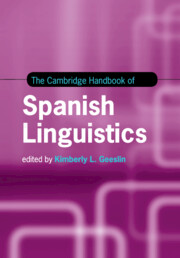Book contents
- The Cambridge Handbook of Spanish Linguistics
- Cambridge Handbooks In Language and Linguistics
- The Cambridge Handbook of Spanish Linguistics
- Copyright page
- Dedication
- Contents
- Figures
- Tables
- Contributors
- Acknowledgements
- Abbreviations
- Introduction
- Part I Theories and Approaches to Spanish Linguistics
- Part II The Spanish Sound System
- Part III Spanish Morphosyntax and Meaning
- 12 Word Phenomena: Category Definition and Word Formation
- 13 Properties of Pronominal Subjects
- 14 Properties of the Verb Phrase: Argument Structure, Ellipsis, and Negation
- 15 Properties of the Extended Verb Phrase: Agreement, the Structure of INFL, and Subjects
- 16 Properties of Nominal Expressions
- 17 Information Structure
- 18 Syntax and its Interfaces
- 19 Lexis
- 20 Pragmatics
- Part IV Spanish in Social, Geographic, and Historical Contexts
- Part V The Acquisition of Spanish
- Index
- References
13 - Properties of Pronominal Subjects
from Part III - Spanish Morphosyntax and Meaning
Published online by Cambridge University Press: 13 August 2018
- The Cambridge Handbook of Spanish Linguistics
- Cambridge Handbooks In Language and Linguistics
- The Cambridge Handbook of Spanish Linguistics
- Copyright page
- Dedication
- Contents
- Figures
- Tables
- Contributors
- Acknowledgements
- Abbreviations
- Introduction
- Part I Theories and Approaches to Spanish Linguistics
- Part II The Spanish Sound System
- Part III Spanish Morphosyntax and Meaning
- 12 Word Phenomena: Category Definition and Word Formation
- 13 Properties of Pronominal Subjects
- 14 Properties of the Verb Phrase: Argument Structure, Ellipsis, and Negation
- 15 Properties of the Extended Verb Phrase: Agreement, the Structure of INFL, and Subjects
- 16 Properties of Nominal Expressions
- 17 Information Structure
- 18 Syntax and its Interfaces
- 19 Lexis
- 20 Pragmatics
- Part IV Spanish in Social, Geographic, and Historical Contexts
- Part V The Acquisition of Spanish
- Index
- References
Summary
- Type
- Chapter
- Information
- The Cambridge Handbook of Spanish Linguistics , pp. 286 - 306Publisher: Cambridge University PressPrint publication year: 2018



